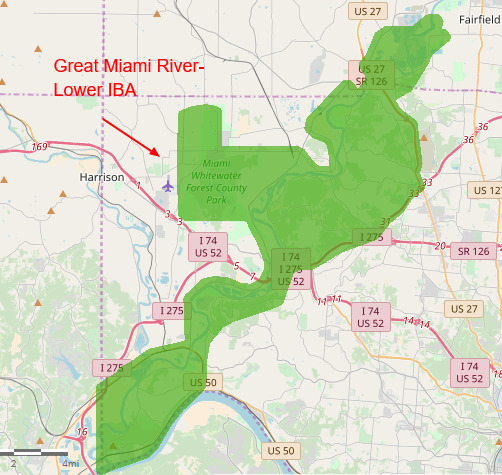Great Miami River-Lower Important Bird Area
Great Miami River-Lower
Important Bird Area
Explore in eBird
Entire Year – Spring – Summer – Fall – Winter
Locations
Butler
Chrisholm MetroPark
Fernald Preserve--North Woods (Butler Co.)
Great Miami River--Low Level Dam
Pyramid Hill Sculpture Park
Rentschler Forest MetroPark
Rentschler Forest Metropark--Line Hill Mound Area
Riverside Natural Area
Hamilton
Campbell Lakes Preserve
Cleves Community Park
Fernald Preserve--Lodge Pond
Fernald Preserve--Sycamore and Shingle Oak Trails
Gravel Pits West of Kilby Rd.
Great Miami River--Lost Bridge
Kilby Rd. Gravel Pits, Smith Tract
Miami Whitewater Forest (please use a more specific location)
Miami Whitewater Forest--Badlands Trail
Miami Whitewater Forest--Bike Trail Inner Loop
Miami Whitewater Forest--Bike Trail Outer Loop
Miami Whitewater Forest--Bowles Woods and Tallgrass Prairie Trail
Miami Whitewater Forest--Golf Course
Miami Whitewater Forest--Great Miami Bottoms and Dog Park
Miami Whitewater Forest--Lake
Miami Whitewater Forest--Shaker Trace Wetlands
Miami Whitewater Forest--Strimple Rd.
Miami Whitewater Forest--Timberlakes and Oakleaf Trails
Miami Whitewater Forest--West Rd. Bridge Environs
Mitchell Memorial Forest
Mitchell Memorial Forest--Mountain Bike Trailhead
Shawnee Lookout
Shawnee Lookout--Blue Jacket Trail
Shawnee Lookout--Boat Ramp
Shawnee Lookout--Former Golf Course Trails
Shawnee Lookout--Little Turtle Trail
Shawnee Lookout--Miami Fort Trail
Montgomery
Crains Run Nature Park
Deeds Point and Vicinity
Great Miami River Trail--East River Rd.

About Great Miami River-Lower Important Bird Area
The Lower Great Miami IBA extends along the Great Miami River south from the city of Hamilton in Butler County to the confluence with the Ohio River in Hamilton County. From Hamilton, the Great Miami River meanders south and west for about 32 river miles. The habitat along the riparian corridor varies in width and includes several important recognized natural areas that, in highly urbanized Hamilton County, are still fairly contiguous. The Whitewater River joins the Great Miami approximately 6 miles upstream from the Ohio River with important associated sites within its valley. The IBA has a wide diversity of habitats including bottomland forest, mixed-species mesic hardwood forest with a dense herbaceous layer, coniferous woodlands, and riparian and mudflat herbaceous communities. Much of this 32-mile corridor is wooded and sycamore, cottonwood, and maple trees predominate. Most of this stretch is semi-rural and still used as farmland, with several small parks along both sides of the river, many abandoned and overgrown gravel pits in the valleys that provide successional and scrubby habitats, some light industry, and several active gravel mining operations. Most of the hillsides in the valley are still heavily wooded, even where homes have been built. And there are still some large contiguous tracts of mature forest, both upland and bottomland, including at least one undisturbed 300-acre tract.